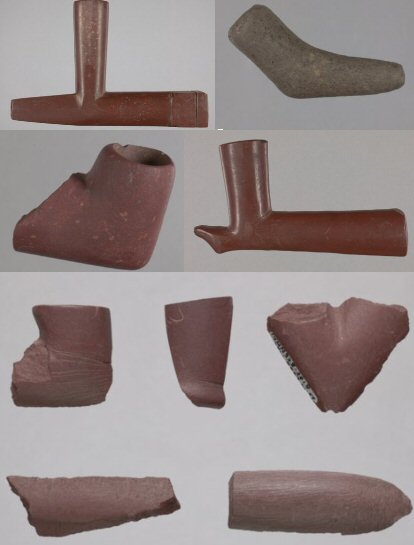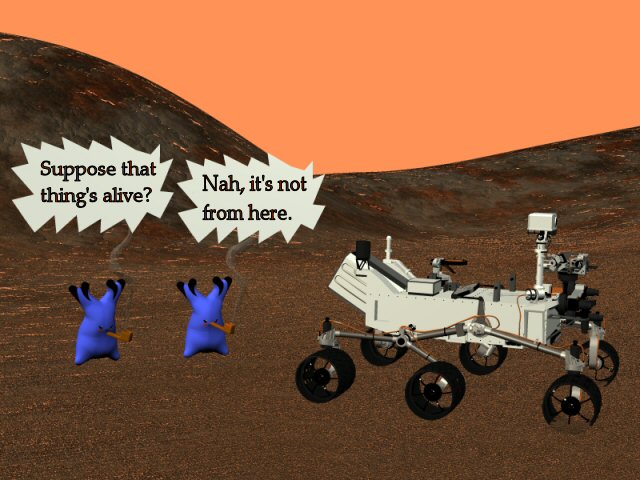Saturday, January 06, 2018
Nice contrast
Excellent paired example of good and bad scientific thinking in a little feature on a new Mars observation.
The rover has spotted some small branching tube-like structures, about a half inch long. To my eyes they suggest earthworm casts, or perhaps semi-structured colonial organisms like algae or coral. I can't think of an inorganic process that makes such shapes.
One of the quoted scientists has a proper Carverian approach:
 Ceramic and stone pipes made by the Kiowa and Kansa tribes. Maybe the old Martian tribes had their own miniature version of tobacco.
Ceramic and stone pipes made by the Kiowa and Kansa tribes. Maybe the old Martian tribes had their own miniature version of tobacco.
 = = = = =
Random semi-related semi-thought: Archeologists have often tried to reproduce ancient beer recipes based on chemical analysis of remnants in jugs and bottles. The above pipes are described as containing remnants of tobacco, but I can't find any similar attempts to reproduce the Kansa blend or the Osage blend. Tobacco is CRIMETHINK because it kills you slowly and improves your thinking. Alcohol is WONDERFUL because it kills you fast and ruins your brain long before it kills you. This is logical by definition.
= = = = =
Random semi-related semi-thought: Archeologists have often tried to reproduce ancient beer recipes based on chemical analysis of remnants in jugs and bottles. The above pipes are described as containing remnants of tobacco, but I can't find any similar attempts to reproduce the Kansa blend or the Osage blend. Tobacco is CRIMETHINK because it kills you slowly and improves your thinking. Alcohol is WONDERFUL because it kills you fast and ruins your brain long before it kills you. This is logical by definition.
But on first view of the features, Lee said that as a field geologist, "the immediate thought that came to my mind is bioturbation." This is the process through which organisms living in sediments can disturb the structure of these sediments. "A common example of bioturbation is the formation of worm burrows. The burrows, once refilled with sediments, fossilized and then exposed by erosion, can end up looking like wiggly sticks," Lee told Inside Outer Space.See what you see, try to compare it and pattern it. No initial assumptions. Carver. Another shows classic theorigenic blindness:
"Cool, looks like bioturbation and would likely be as such identified if the image would be from Earth," said Schulze-Makuch. "But concretions can look quite similar, and, in [the] case of Mars, it's … more likely concretions," he added, referring to formations of precipitated minerals.It's from Mars, therefore it can't be life. Theorigenic blindness, aka prejudice. See also theories vs patents. = = = = = Later: Come to think of it, those shapes DO remind me of something inorganic:
 Ceramic and stone pipes made by the Kiowa and Kansa tribes. Maybe the old Martian tribes had their own miniature version of tobacco.
Ceramic and stone pipes made by the Kiowa and Kansa tribes. Maybe the old Martian tribes had their own miniature version of tobacco.
 = = = = =
Random semi-related semi-thought: Archeologists have often tried to reproduce ancient beer recipes based on chemical analysis of remnants in jugs and bottles. The above pipes are described as containing remnants of tobacco, but I can't find any similar attempts to reproduce the Kansa blend or the Osage blend. Tobacco is CRIMETHINK because it kills you slowly and improves your thinking. Alcohol is WONDERFUL because it kills you fast and ruins your brain long before it kills you. This is logical by definition.
= = = = =
Random semi-related semi-thought: Archeologists have often tried to reproduce ancient beer recipes based on chemical analysis of remnants in jugs and bottles. The above pipes are described as containing remnants of tobacco, but I can't find any similar attempts to reproduce the Kansa blend or the Osage blend. Tobacco is CRIMETHINK because it kills you slowly and improves your thinking. Alcohol is WONDERFUL because it kills you fast and ruins your brain long before it kills you. This is logical by definition.Labels: Carver
